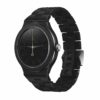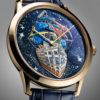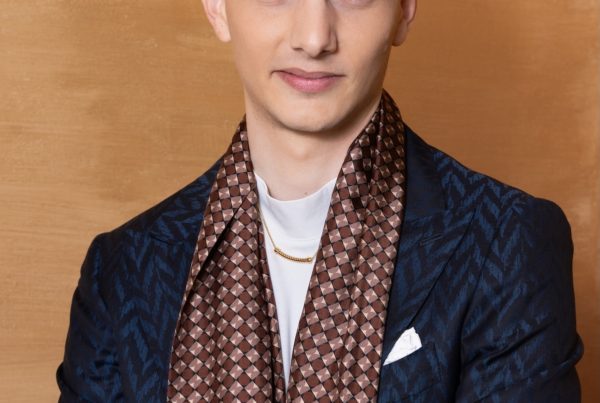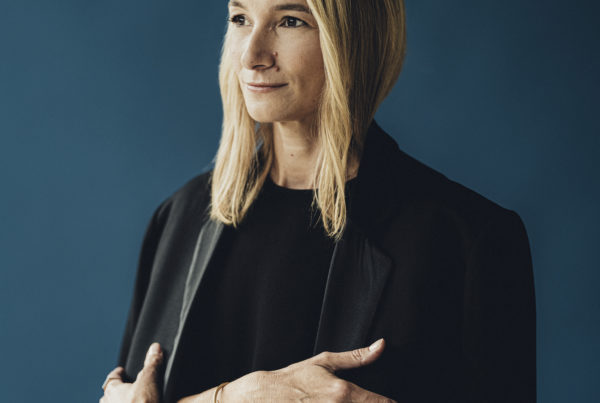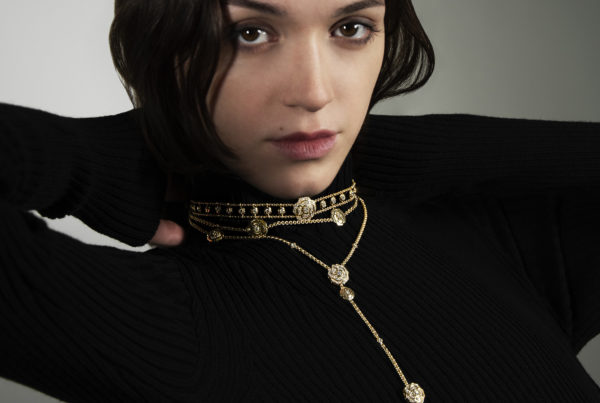The irreverent jewellery and poetry of Lorenz Bäumer
This engineer who became a jeweller by passion, claims to be the only independent jeweller on the Place Vendôme. His creations are a form of precious autobiography that recounts his travels, his emotions and his dreams. His latest creation? A highly irreverent dinner service that recalls his world of beetles, spiders and humour. Interview. Isabelle Cerboneschi

If you accept an invitation to dine at the home of jeweller Lorenz Bäumer, you can expect anything, especially to be insulted by your plate. Underneath the question mark napkin, you may well be called a “little bitch» or a “micro bastard”. But it’s nothing personal. It’s just a way to break the ice between guests who hardly know each other and to laugh – or not – depending on the degree of humour that nature has endowed us with. The host makes up for it with the dessert plates, filled with tender words that allow the evening to end gently.
The table service designed by the jeweller is just like his creations: poetic, symbolic, unusual, unexpected, full of humour, love, in short, different.
This son of a diplomat grew up with his father’s postings and the landscapes that surrounded him ended up being infused into his jewellery. Trained at the prestigious Ecole Centrale de Paris initially, Lorenz Bäumer is an engineer, but once he had his diploma, he decided to create costume jewellery first, in 1988, before creating his own jewellery house in 1992.
In 1988, he was spotted by Chanel, for whom he designed the jewellery collections for twenty years: the famous Camélia, Matelassée, Coco rings and so many other iconic pieces are all his doing. In 2009, it was Louis Vuitton’s turn to call on him as artistic director of jewellery. He created the brand’s first line of jewellery, “L’Ame du voyage”. It was followed by many others. This adventure will last until 2015.
After winning an anonymous competition organised by the Palace of Monaco, Lorenz Bäumer was entrusted with the creation of the Ecume de Diamants tiara, worn by Charlene Wittstock at her wedding to HSH Prince Albert II of Monaco in 2010.
He creates jewels that stand out for their uniqueness. They reflect his inner world, as well as his technical discoveries: we owe him the tattooed diamond or the perfumed rings. One navigates between two worlds with him: that of magic and that of technology. And often these two worlds come together.

What led you to create tableware?
Lorenz Bäumer: My mother paints on porcelain and when I was a child I used to draw models for her. It’s a different way of approaching design in everyday life. These objects do not dress the person but the house and make life more beautiful. During the lock down, we couldn’t go to restaurants and I sometimes invited friends to lunch in my salons at Place Vendôme. Then I said to myself that it would be nice to create a universe for the table that tells my story, that generates conviviality, while being a wink.
Your plates are more than a wink! You have chosen some rather daring themes such as insects, which might repel some people, and sweet and sour words ranging from bitch to bastard and from goddess to darling. Did this idea come from the memory of a particularly unpleasant dinner?
Actually, I want to translate what I do with jewellery into tableware. They are both classic and irreverent, and they tell a story by translating our know-how. At a dinner party, sometimes guests who don’t know each other can be a bit borrowed. This service is a way to break the ice with humour. All my guests have some. A napkin with a question mark on it hides the plate and when you take it off, you find an insult. But it’s written in a very soft way, with little flowers, it’s very cute, a bit bourgeois. I used a font that was invented by the Sèvres porcelain factory for Catherine the Great or for Madame du Barry, they say…
It is better not to have a table plan!
No way! What makes me laugh is to see the faces of my guests. They have to look twice to make sure they have read the text correctly. And then they look at the neighbour’s face and think: “Phew, I’m not alone! » And the next question is: “Why did you choose that word for me? » The answer is that it is chance and that the host has not missed a trick either. It is designed as a journey: the main plates are decorated with swear words, the bread plates are adjectives: small, huge, micro, etc. There are six for men and six for women and they match up randomly.
But what if some of your guests don’t have any sense of humour?
People who don’t have any sense of humour, you don’t want to have dinner with them. But in the end, everyone finds it very funny because it’s not done to anyone’s detriment: everyone gets to do it. But you have to end on a good note and for the dessert I chose sweet words: love, goddess, darling, muse… As for the service with beetles, they are inspired by my jewellery. I love the magic of these animals that seem to come out of prehistoric times. They were a symbol of longevity in ancient Egypt. Sometimes people have a phobia about beetles, so I’ve supplemented them with spiders (laughs).
Several of your jewellery lines celebrate love: “Inseparable”, “Think of me”, “Heartbeat”, “Madness”. Can your creations be described as jewellery of feelings?
I love the phrase attributed to Oscar Wilde: “Beauty lies in the eye of the beholder”. Everyone can see in my jewellery what they wish to perceive. It can be love, the bond between a grandmother and her granddaughter, a parent and a child, or just a bond with oneself. I like it when jewellery, beyond being gold and diamonds, tells something. It’s like a language that creates a dialogue between two people: the one who buys it and the one who receives it.
With your jewels, do you write your autobiography without words?
Yes, to some extent. They tell the story of my life, because I put a lot of myself into them. It’s not a marketing approach but a personal one: a bit like psychoanalysis. Through my creations, I take pleasure in sharing the things I love in life, the moments I have experienced and that I want others to experience too.
A piece of jewellery is an ornament but also a message, a way of affirming who you are at a given moment in your life. Do you think it can have the magic of accompanying a person in their metamorphosis?
I designed my new line “Metamorphosis” during the confinement with this idea of reinventing oneself. The motifs are trees and leaves that become a butterfly depending on how you look at them. I try to change the way people look at themselves or at others, through the jewels we offer them. This magic is what I try to instil in my creations.

How did you get the idea to tattoo a diamond?
Most inventions are found at an intersection where the need for something, a moment in time and technology come together. This diamond tattoo business is a mixture of all these things. First there was a desire: I love tattoos but I hate the idea of having something permanent on me. Secondly, laser technology allows a diamond to be heated very locally, imperceptibly. By burning the carbon of which it is made, the diamond becomes black. A small drawing made by hand is deposited on the stone in a very superficial way, without altering its value, and this is translated technologically. In the 19th century, diamonds were engraved by scratching them with another diamond, but laser tattooing was not an option. Everyone can choose their own tattoo. I usually draw them, but you could also bring me a child’s drawing to be engraved on a diamond for eternity. It would be a great gift for Mother’s Day.
Can these tattoos be removed?
Yes, by re-polishing the diamond.
A piece of jewellery generally appeals to three senses: it can be seen, touched and heard. But you have introduced a fourth sense: smell, with your scented rings. Is this a way of bringing the tradition of the pomander, the scented apple, up to date?
I wanted to introduce olfaction into the world of jewellery. So I had to use technology again, even though I always try to hide it. I used the technique of 3D printing, which makes it possible to make three-dimensional objects that are in fact superficial layers of material. This means that you can leave a void inside, which is not possible when you cast metal using the lost wax technique, which gives a solid material. Thus, we can obtain a porous material in metal and the perfume is impregnated in it, as if it were a sponge. Technology allows us to create this material, but I don’t talk about it because I’m an engineer and I want it to be at the service of beauty, without appearing. Luxury has never been driven by technology, but by the beauty of an object and the dream attached to it.
In the 12th century, scented jewellery had a purpose: it was thought that the scent of musk or ambergris protected against plague epidemics, for example. Why add this dimension today?
Because it’s a world I love and we have our own perfume. At some point, I would have liked to become a perfumer. But in no way does my jewellery protect against Covid (laughs).

You are the last independent jeweller with a boutique litterally on the Place Vendôme. What are the difficulties that one encounters today when one is independent?
We encounter a lot of them every day! You encounter them because you are too small, because others block your access, but in each situation there are advantages and disadvantages. I often say that my fellow jewellers, who belong to large groups, drive buses and I drive a Ferrari. You have to be careful about going off the road, but you can do things that others cannot. But I don’t have the same financial means as them.
Is the Battements de cœur (Heartbeats) jewellery personalised with an electrocardiogram provided to you or have you predefined the shape?
Both: you can order your own heartbeat or buy the one we have designed.

I remember a necklace you designed for Louis Vuitton that represented the Champs Elysées seen from above: the diamonds and rubies were like the headlights of cars. It was both geometric and figurative. How did you come up with this idea?
My son Carl came up with the idea for the necklace. I teach my children to recognise stones and one evening when we were down the Champs Elysées, my son, who must have been 6 or 7 years old, said to me: “Look, Dad, there are lots of rubies on one side of the Champs Elysées and on the other side, there are diamonds!” He was looking at the line of cars going up and down.
Where does your inspiration come from?
From different things: a technique, a beautiful material, something I see, or a flash. I often get ideas in the shower. You’re alone there, the phone doesn’t ring. Water is my element, which takes everything away. I stay with the essential.
Since the creation of your company, customer habits have changed, especially with the emergence of a wealthy and enlightened Chinese clientele and the arrival of millenials. What is the current trend and how are you adapting to these changes in consumption patterns?
Humans remain the same: they want good, beautiful and real things, even if they may look at each of these things differently. I am not a marketing man. I am a creator and I will create what I like and not what others like. But I wish to be of my time and even a little ahead of it. Today we live in complicated times and people need to have talismans that inspire them and speak to them. This is how the “Metamorphosis” collection was born. We have also created pendants, like shields, which symbolically protect. We are also thinking about NFTs. An NFT is not a virtual jewel: it’s a certificate that entitles you to the real thing or to something special that you can sell and give to someone else. Perhaps you will receive the drawings of your own jewel in NFT format, or the possibility to buy, under certain conditions, the earrings that go with a necklace or with a ring. You have to be in tune with the times.

In your shop there is a secret room. Finally, you are a great dreamer, both chivalrous and a bit of a magician. Was creating jewellery a childhood dream?
I have always loved the idea of jewellery. My parents were diplomats and when my mother put on her jewels, she was no longer my mother but a princess. What we create is part of this universe, with knights, princesses, women who transform themselves, Cinderella… A piece of jewellery is both a dream and at the same time it is very concrete. It’s not only a fairy tale: it also has an investment dimension. This is he mixture of the two that is so interesting and fun.
Speaking of which, when you design, in addition to the creative act, do you choose stones based on their investment value?
Not only do I think about it, but it’s essential! If a client buys a piece of jewellery from me, it would not be respectful not to take this investment dimension into account. In my job, there is a part of advice: not only aesthetic but also financial. There are materials that I advise on exactly as if they were for me. A few years ago, for example, I told all my clients to buy spinel, because it is a magnificent stone. Not all of them followed me, but in the meantime the prices have exploded! I don’t want to be an investor in stones, because otherwise I won’t sell anything, but I give advice and at the moment I invite my clients to bet on coloured diamonds. By the way, the price of all natural diamonds has increased a lot.
What would be your ultimate piece of jewellery or the piece that technically you cannot yet make?
It would be a piece of jewellery that allows you to connect directly to emotions, without going through the filter of the senses. It would be something poetic and a bit crazy. And why not a jewel coloured with love…?


















